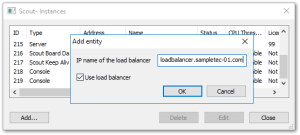Scout Server cluster
If you use an SQL database, several Scout Servers can connect to the same Scout database concurrently. Concurrent Scout Servers enable failure load balancing as well as the option to configure load balancing (ManagerLoadBalancing).
Client devices that connect to a Scout Server receive a list of all currently running servers that access the shared Scout database.
FailureLoadBalancing
On start-up, a device tries to connect to the Scout Server it was connected to last time. If, however, that server is not available, it connects to the next server from the servers list which, subsequently, becomes the server the client tries to access by default from then on.
The FailureLoadBalancing mechanism restarts as soon as the client fails to connect to the same Scout Server.
ManagerLoadBalancing by dedicated load balancer
To define a dedicated load balancer, predefine the preferred manager address (IP address or name) for load balancing you want the devices to connect to:
-
In the Scout Console, in View > Scout entities, add a new entity and select the option Use load balancer.
The load balancer entry refers to an existing load balancer pointing to the relevant Scout Server. The load balancer entry allows you to assign devices to a particular Scout Server without changing the Scout configuration.
The load balancer name is evaluated by the devices on each client restart.
Procedure:
- The device restarts
- The device connects to the load balancer and then is forwarded to the appropriate Scout Server
If, however, the Scout Server identified by the DNS entry ManagerLoadBalancer is not available, the FailureLoadBalancing mechanism described above is used and the client accesses the next server on the list.
ManagerLoadBalancing by DNS entry
Alternatively, to predefine a preferred Scout Server you want the devices to connect to, you can use a DNS entry that you refer to in the advanced file entries.
-
Use the Scout Console feature Advanced file entries for all devices, for an OU or an individual device:
File /setup/terminal.ini Section Network Entry ManagerLoadBalancer Value <FQDN DNS entry> For further information, see Advanced file entries.
ManagerLoadBalancer refers to a DNS entry pointing to the relevant Scout Server. In a separate step, the DNS entry must be defined on the DNS server. The DNS entry allows you to assign devices to a particular Scout Server without changing the Scout configuration.
The ManagerLoadBalancer parameter is evaluated by the devices on each client restart.
Procedure:
- The device restarts
- DNS entry ManagerLoadBalancer is resolved
- The device connects to the appropriate Scout Server
If, however, the Scout Server identified by the DNS entry ManagerLoadBalancer is not available, the FailureLoadBalancing mechanism described above is used and the client accesses the next server on the list.



